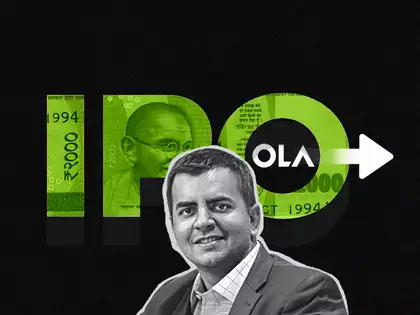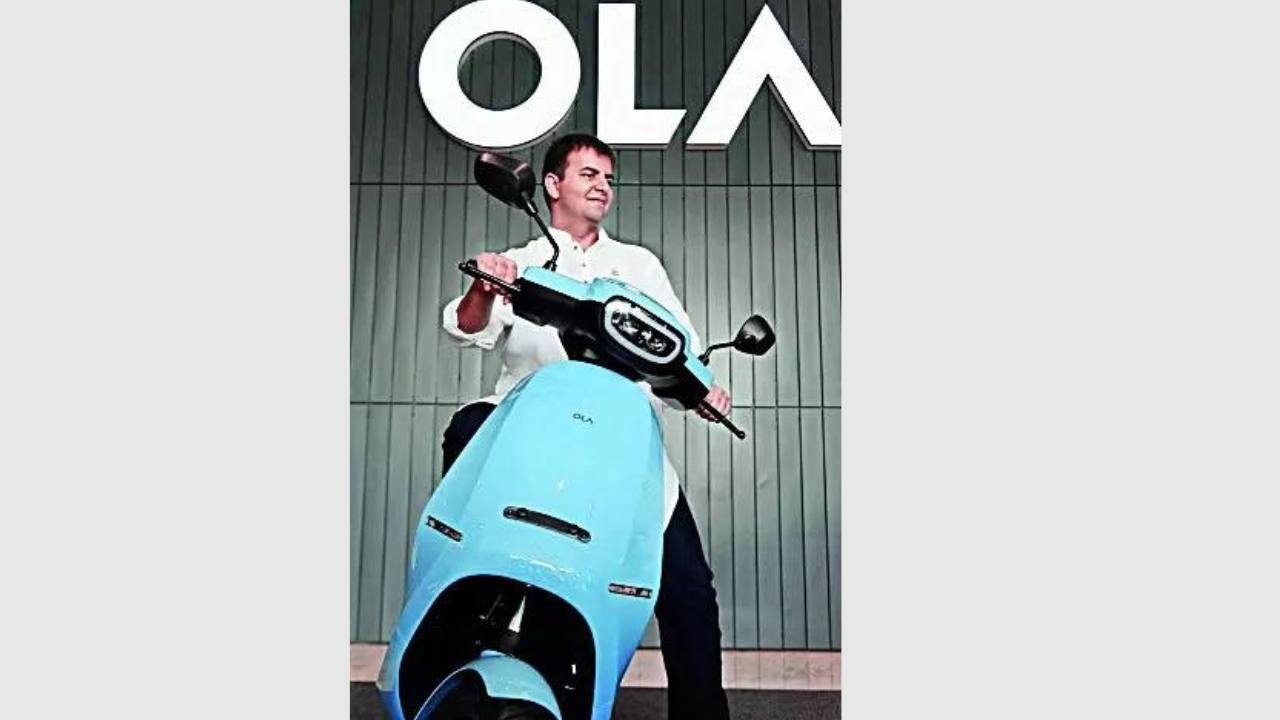Bhavish Aggarwal And Existing Investors To Offload Their Stake Of About $80 Million In Ola Electric To IPO Investors. Why Is The Founder In Such A Hurry To Sell Almost Half Of His Stake?
SoftBank-backed Ola Electric is set to debut in what will be India's biggest IPO this year, aiming to raise approximately $740 million. The company's stock market debut, scheduled for August 1-6, will see shares priced between 72-76 rupees ($0.86-$0.91). Despite leading the e-scooter market in the country and attracting significant investor interest, Ola Electric faces substantial financial challenges, having reported escalating losses over recent years and here comes the googly - Bhavish Aggarwal and existing investors are set to offload their stake of about $80 million to IPO investors, this is a tale of caution!

If Bhavish Aggarwal Believes In His Business Model Of Ola Electric Then Why Sell Almost Half His Stake?
A newspaper advertisement announced that SoftBank-backed Indian e-scooter maker Ola Electric plans to offer shares in the price range of 72-76 rupees ($0.86-$0.91) in its upcoming stock market listing.
The listing will begin this week and is expected to be one of India’s largest IPOs this year; the company’s advertisement in the Financial Express detailed the 72-76 rupee price band, with a 7-rupee per share discount for eligible employees participating in the IPO.
The subscription period for the IPO is from August 1 to August 6.
Ola Electric’s IPO, valued at approximately $740 million, marks the first IPO by an Indian electric vehicle manufacturer and is set to attract investment bids from Fidelity, Nomura, Norges Bank, and several Indian mutual funds, according to a report by Reuters on Monday.
Ola’s IPO will involve the issuance of new shares to raise $660 million, alongside the sale of existing shares by investors, including founder Bhavish Aggarwal, totalling around $80 million.

Now that we know the details, there is one pressing question – why is the founder and CEO Bhavish Aggarwal so eager to cash out?
He intends to sell 47.3 million shares, which is half of the total shares available for sale.
In terms of competition, Ola faces rivals like TVS Motors, Bajaj Auto, and Ather Energy.
According to the DRHP, the funds from the Ola Electric IPO will be allocated for capital expenditure, debt repayment, and research and development (R&D).
Specifically, about Rs 1,226 crore will be used for capex, Rs 800 crore for debt repayment, Rs 1,600 crore for R&D, and Rs 350 crore for inorganic growth.
From Losses To The IPO Jump
Despite these plans, the fact is Ola Electric remains a loss-making company with no clear path to profitability.
In December 2022, the company halved its sales targets for 2023-2025 and delayed its profitability goal by a year due to reduced government incentives that increased e-scooter prices.
Although its revenue from operations increased over sevenfold to ₹2,631 crore, its total loss for the fiscal year ending March 2023 rose to ₹14.72 billion ($176.14 million).
In the first quarter of FY24, Ola Electric reported a net loss of ₹267 crore and an operating revenue of ₹1,243 crore.
The company’s financial woes have been significant in recent years –
FY 2023: Loss of ₹1,472.08 crore
FY 2022: Loss of ₹1,292 crore
FY 2021: Loss of ₹1,174 crore
FY 2020: Loss of ₹890 crore
FY 2019: Loss of ₹625 crore
These figures emphasise a pattern of increasing losses, casting doubt on the company’s sustainability and growth prospects.
For the fiscal year 2023, ANI Technologies, the parent company of the Ola brand, reported a consolidated net loss of ₹772.25 crore.
Now, let us take a look at ANI Technologies financial performance over the years –
FY 2023: Loss of ₹772.25 crore
FY 2022: Loss of ₹1,108 crore
FY 2021: Loss of ₹924 crore
FY 2020: Loss of ₹659 crore
FY 2019: Loss of ₹556 crore
Again, these substantial losses indicate a troubling trend.

Impaired Business Model
While persistent losses are a significant concern, as seen above, the lack of a clear path to profitability is even more troubling.
Ola Electric gained significant attention for its “state-of-the-art” electric scooters but failed to deliver due to flawed designs, which will be discussed later in this article.
Likewise, Ola Cabs, the ride-hailing arm of the parent company, also faces challenges in achieving profitability due to a flawed business model and perhaps recognizing this early on, the leadership launched Ola Electric, still nothing much seems to have changed when it comes to the path of profitability.
So what happened with Ola Cabs?
The leadership’s failure to understand the product-market fit demonstrates incompetence.
Initially, heavy discounts from Uber and Ola allowed lower-income individuals to use cab services weekly, making the cost comparable to auto-rickshaws.
This phenomenon, termed “market disruption,” was actually a massive burn of capital and Uber and Ola together have consumed over INR 30,000 crores.
As the funding environment tightened and investors demanded profits, discounts decreased, pushing people back to public transportation and rickshaws.
Hence, the problem isn’t company apathy but the business model’s inability to scale. It works well as a niche service for the affluent, who can afford the actual cost of an air-conditioned taxi.
Startup enthusiasts claim these investments are made with the “future” in mind, believing these “habit-forming” services will eventually become profitable as India’s discretionary spending increases.
However, this business model is based on a future that may never materialize, making the path to profitability highly uncertain.
Considering India’s huge problem of income inequality and job losses at what income level would an average individual be willing to pay a premium for such amenities?

Hence, given the facts here are some of the reasons as to why avoid investing in the Ola Electric IPO
1) Bhavish Aggarwal And Early Investors Selling Large Amounts of Shares
A key concern in the Ola IPO is the significant amount of shares being sold by founder Bhavish Aggarwal and early investors.
Aggarwal plans to offload 4.73 crore equity shares in the offering, representing nearly 50% of his holdings; this raises questions about his confidence in Ola Electric’s future prospects.
Before the IPO, Aggarwal held a 36.94% stake in Ola Electric, while ANI Technologies and Indus Trust owned 4.35% and 3.85%, respectively.
Major shareholders like SVF II Ostrich (21.98%), Alpha Wave Ventures II (3.49%), Internet Fund III (6.03%), and MacRitchie Investments (1.25%) have also reduced their stakes post-IPO.
If these key investors are selling off their shares, it may signal a lack of faith in the company’s future since it is unusual for a founder to divest such a substantial portion of their stake unless they no longer believe in the company’s potential.
Hence, all the more reason why potential investors should exercise caution when considering a company where the promoters are seemingly distancing themselves.
2) Product Quality Issues
Ola Electric has faced numerous reports of defects and quality issues, impacting its reputation in the EV market. Problems include battery malfunctions and overall vehicle reliability concerns, which undermine consumer trust.
Ola Electric claimed to have sold over 100,000 scooters on the first day but failed to meet its delivery promise, citing a semiconductor chip shortage.
However, the commitment to deliver within a month was not met, raising questions about their readiness for production.
In April, concerns were raised when images surfaced showing a blue Ola S1 Pro with a detached front tire after a collision in Maharashtra.
This showed potential flaws in the scooter’s front fork limb, which is crucial for steering in challenging terrain. Inspired by Etergo’s Appscooter from the Netherlands, the design was not adequately adapted for Indian conditions, leading to safety issues.
Reports also indicated that the scooter’s suspension, made from high-pressure aluminum die-casting, failed under stress, particularly when riders applied the brakes suddenly. The design, more suited for smooth European roads, proved problematic in India’s diverse conditions.
Despite having fewer than 50,000 scooters on the road at the time of the initial incident, Ola did not address the design flaws or issue a recall, opting instead to continue production.
This approach contrasts with industry practices where recalls are used to rectify mechanical and engineering errors, demonstrating a prioritization of brand reputation over passenger safety.
And how can one forget the recurring problem of Ola Electric’s “burning” incidents?
Thus, Investors should be wary of a company that seems more focused on maintaining its image than on addressing critical safety issues.

3. Increasing Competition from Other OEMs
Ola Electric reported that the S1 Pro model offers a driving range of 195 km, while the S1 Air is advertised with a range of 151 km.
However, the actual range is about 40% lower, with the S1 Pro achieving roughly 130 km and the S1 Air around 90-100 km, and both figures further decrease with a passenger.
Ola has faced criticism for presenting certified ranges based on laboratory tests, which do not reflect real-world conditions on Indian roads, thus misleading consumers.
In contrast, competitors like Ather and TVS provide more accurate range information; for instance, TVS reveals a real-world range of 100 km for its electric scooter.
Despite gaining a significant market share through substantial discounts, Ola Electric is now under pressure from well-established rivals such as Bajaj and TVS, coupled with persistent product issues.
4. Founder Wearing To Many Hats Raise Concerns
The DRHP highlights that Bhavish Aggarwal, the founder of Ola Electric, is involved in several other ventures.
From being a Chairman and Managing Director of Ola Electric, as well as his roles in Krutrim SI Designs Private Limited and ANI Technologies Private Limited, there are concerns about whether Aggarwal can dedicate sufficient time and effort to Ola Electric.
Additionally, Aggarwal’s connection with Tork Motors Private Limited, a competitor in the same sector, raises potential conflicts of interest that could negatively impact Ola Electric’s operations.
The significance of this issue is evident from the numerous reports of fire incidents, service-related problems, and other concerns regarding Ola Electric’s two-wheelers, coupled with a perceived lack of accountability from Aggarwal.

5. Stagnating EV Sales
The Indian electric two-wheeler market has seen stagnant sales over the past three months.
In May, registrations of high-speed electric two-wheelers dropped by 27% compared to the same period last year, a decline attributed to a surge in pre-purchases spurred by the government’s substantial reduction in FAME-II subsidies starting June 1, 2023.
To bridge the gap between the end of FAME-II (March 31, 2024) and the upcoming FAME-III scheme, the government has further cut subsidies since April.
Although Ola Electric maintained a 48% market share in May, the overall percentage of electric vehicles (EVs) in the total two-wheeler market remained unchanged at 5% from the previous year.
Investors are increasingly concerned about finding new growth drivers in the electric two-wheeler market.
An anonymous investor involved in an IPO remarked, “We are seeking the next growth catalyst in the e-two-wheeler sector.” The recent stagnation has shifted the focus of EV companies toward efficient capital use and profitability.
Likewise, as subsidies for e-two-wheelers are expected to decrease, evaluating the sustainability of these businesses becomes even more critical.
The electric scooter market is becoming more competitive, with established players like Bajaj Auto and TVS Motors increasing their market shares to 19% and 12%, respectively, in FY24.
6. Closure of International Operations to Focus on Domestic Market
Ola Cabs ceased its international operations in the United Kingdom, New Zealand, and Australia, citing a need to concentrate on its domestic business due to rapid growth.
However, these international markets offer significant opportunities for both electric vehicles (EVs) and traditional cab services, thanks to higher disposable incomes that make cab usage more accessible compared to India.
Thus, this move raises questions about the company’s strategic vision and execution.
If the intention was to focus on the domestic market, why has the Indian segment not yet achieved profitability or shown a clear path to it?
Additionally, the decision of Bhavish Aggarwal to offload his shares further complicates the situation.

7. High Attrition Rate and Toxic Work Culture
The DRHP reveals a troubling attrition rate of 42.06% for the seven months ending October 31, 2023, and 47.48% for Fiscal 2023.
The company laid off 200 employees across various departments in January of the previous year.
Ola Electric is currently in the process of laying off approximately 400-500 more employees as founder Bhavish Aggarwal focuses on managing operating costs ahead of the company’s IPO.
The company has experienced significant leadership turnover, with CFO Karthik Gupta resigning on May 16 after just seven months and CEO Hemant Bakshi leaving after only four months. This high turnover suggests possible internal challenges.
Ola Cabs responded to inquiries about the layoffs, stating, “We conduct ongoing restructuring exercises to enhance efficiency, and some positions have become redundant. We will continue to recruit new talent in engineering and design, including senior roles in our key areas of focus.”
Criticism of Ola’s work environment persists, with reports of a toxic atmosphere leading to high employee turnover. Many employees, reportedly overburdened and underpaid, leave within a year. Recent actions, including withholding 20% of the variable compensation owed to senior management, have exacerbated concerns.
High employee turnover can disrupt operations, impede innovation, and increase recruitment costs. Given the EV market’s heavy reliance on research and development, the loss of skilled talent could impact Ola’s ability to innovate and stay competitive.
8. Lack of Accountability
The Securities and Exchange Board of India (SEBI) has a troubling history of approving IPOs for loss-making companies, resulting in significant financial losses for retail investors. This repeated regulatory oversight raises serious questions about SEBI’s commitment to protecting investor interests and maintaining market integrity.
The pattern of allowing these IPOs despite their subsequent failures suggests either gross incompetence or potential malfeasance within the regulatory body.
9. Unclear Utilization of IPO Proceeds
Ola Electric’s substantial debt is a major red flag.
The company has indicated that it will continue to face operational losses as it focuses on expanding its business and product offerings. This level of debt raises concerns about the company’s financial stability and its ability to handle long-term obligations.
The compensation structure for Ola Electric’s top executives, including founder Bhavish Aggarwal’s base salary of ₹6 crore per year and variable pay of ₹3 crore, along with additional fees for non-executive and independent directors, may be viewed as excessive. Such high costs could potentially impact shareholder value.
Ola Electric plans to invest heavily in diversification and expansion, including an expected ₹1,600 crore for Research and Development (R&D) over the next three years. However, R&D should ideally be conducted before product release, not after.
The Last Bit, The lack of a clear strategy for the utilization of IPO funds and the possibility of wasteful expenditures accentuate concerns about the effectiveness of Ola Electric’s financial management and strategic planning.
Given these issues, despite the excitement surrounding the IPO, it is important to remain cautious and thoroughly evaluate the risks associated with investing in Ola Electric.




